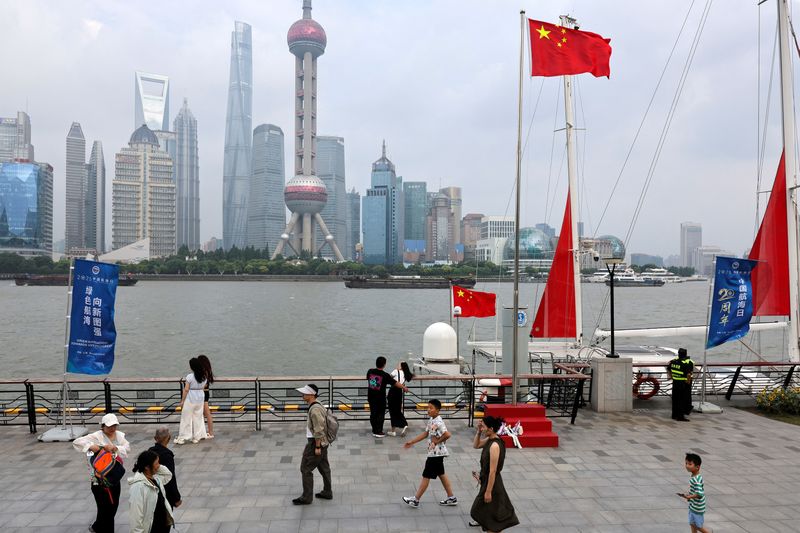BEIJING (Reuters) -Chinese state firm employee Zhang Jinming makes up for a 24% cut to his salary by delivering food for three hours every night after work and on weekends – and hopes he can avoid awkward encounters with colleagues.
“Being a part-time delivery person while working for a state-owned enterprise isn’t exactly considered respectable,” said Zhang, whose real estate firm pays him 4,200 yuan ($585) per month, down from 5,500 yuan.
While China has supported economic growth by keeping its ports and factories humming, the lack of real demand has hit profits, in turn squeezing workers like Zhang through wage cuts and forcing them to moonlight.
“There’s just no other way,” added the 30-year-old, who rides his scooter until 11.30 pm, making 60-70 yuan per evening. “The pay cut has put me under huge pressure. Many colleagues have resigned and I took over their workload.”
China’s economy posted robust 5.2% growth in the second quarter, showing its export-heavy model has so far withstood U.S. tariffs. But beneath the headline resilience, cracks are widening.
Contract and bill payment delays are rising, including among export champions like the autos and electronics industries and at utilities, whose owners, indebted local governments, have to run a tight shop while shoring up tariff-hit factories.
Ferocious competition for a slice of external demand, hit by global trade tensions, is crimping industrial profits, fuelling factory-gate deflation even as export volumes climb. Workers bear the brunt of companies cutting costs.
Falling profits and wages shrank tax revenues, pressuring state employers like Zhang’s to cut costs as well. In pockets of the financial system, non-performing loans are surging as authorities push banks to lend more.
For the most part, the lopsided nature of growth in the world’s second-largest economy is a product of policies that favour exporters over consumers.
Economists have long urged Beijing to redirect support to domestically focused sectors, such as education and healthcare, or boost household consumption – for instance, by bolstering welfare – or risk a slowdown in the second half of the year.
Max Zenglein, Asia-Pacific senior economist at the Conference Board of Asia, describes China as a “dual-speed economy” with strong industry and weak consumption, noting the two are related.
“Some of the economic challenges including low profitability and deflationary pressure are largely driven by continued capacity expansion in the manufacturing and technology sectors,” said Zenglein.
“What’s unfolding now” in the trade war with the U.S. is “coming back home as a domestic issue.”
HIT TO INCOMES
Frank Huang, a 28-year-old teacher in Chongzuo, a city of more than 2 million people near the Vietnam border, in the indebted Guangxi region, says his school has not paid him in two-to-three months, waiting for authorities to provide the funds.
“I can only endure, I don’t dare to quit,” said Huang, who relies on parents when his 5,000 yuan paycheck doesn’t arrive. “If I were married with a mortgage, car loan and child, the pressure would be unimaginable.”
Another teacher from Linquan, a rural county of 1.5 million in eastern China, said she is only receiving her basic 3,000 yuan monthly salary. The performance-based part of her pay, usually about 16%, “has been consistently delayed.”
“After I pay for gas, parking and property management fees, what’s left isn’t enough for groceries,” said the teacher, who only gave her surname Yun for privacy reasons.
“I feel like begging,” added Yun. “If it weren’t for my parents, I would starve.”
There is no data on payment delays in the government sector. But among industrial firms, arrears have grown quickly in sectors with a strong state presence, either through industrial policy or – like in utilities – through direct ownership.
Arrears in the computer, communication and electronic equipment sector and in autos manufacturing – two priorities for China’s economic planners – rose by 16.6% and 11.2%, respectively, in the year through May, faster than the 9% average across industries. Overdue payments were up 17.1% and 11.1% in the water and gas sectors.
These figures suggest liquidity stress and are a side-effect of authorities prioritising output over demand, said Minxiong Liao, senior economist at GlobalData.TS Lombard APAC.
“The result should be slower growth for these champion sectors,” in the future, he said.
SPENDING DEFERRED
With incomes under pressure, Beijing is struggling to meet its pledge to lift household consumption and worries are growing that persistent deflation will further damage the economy as consumers defer spending.
Huang Tingting quit her waitress job last month after business at her restaurant – and most shops nearby – plummeted in April, at the height of U.S.-China trade tensions. Responding to plunging revenues, the restaurant owner asked staff to take four unpaid leave days every month.
“I still have to pay rent and live my life,” said the 20-year-old from the eastern Jiangsu province, an export powerhouse that’s outpacing national growth, explaining why she quit.
In the past, though, she could find another restaurant job in a day or two. This time, she’s been unemployed since June. One recruiter told her a job she applied for had more than 10 other candidates.
“The job market this year is worse than last year,” said Huang.
($1 = 7.1799 Chinese yuan)
(Reporting by Liangping Gao and Ellen Zhang in Beijing; Claire Fu in Singapore; Marius Zaharia in Hong Kong; Graphics by Kripa Jayaram; writing by Marius Zaharia; Editing by Sam Holmes)


